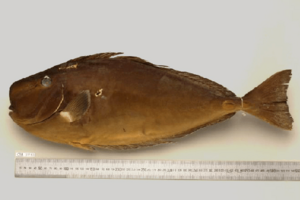Squarenose unicornfish facts for kids
Quick facts for kids Squarenose unicornfish |
|
|---|---|
 |
|
| Conservation status | |
| Scientific classification |
The squarenose unicornfish (Naso mcdadei) is a cool type of fish that lives in the ocean. It's part of a group of fish called Acanthuridae, which includes surgeonfishes and tangs. You can find this fish in the Indo-Pacific area, which is a big part of the Indian and Pacific Oceans.
Contents
About the Squarenose Unicornfish
How Scientists Named It
Scientists give every living thing a special name. This helps them organize and study different species. The squarenose unicornfish was first officially described in 2002. An Australian fish expert named Jeffrey W. Johnson gave it its scientific name. He worked at the Queensland Museum. The first fish he studied to describe this species came from Flat Rock, near Stradbroke Island in Queensland, Australia.
This fish belongs to a group of fish called Naso. This group is the only one in the subfamily Nasinae. All these fish are part of the larger family called Acanthuridae.
Why It's Called McDadei
The second part of the fish's scientific name, mcdadei, honors a person. It's named after Michael McDade. He is a spearfisher and helps with records for the Australian Underwater Federation. Michael McDade helped scientists a lot. He collected and gave many rare fish to the Queensland Museum. One of these fish was the very first squarenose unicornfish that scientists used to describe the species.
What the Squarenose Unicornfish Looks Like
This fish has a unique look! It has a dorsal fin on its back with 5 strong spines and 28 to 31 soft rays. Its anal fin on its belly has 2 spines and 26 to 29 soft rays.
Its Teeth and Body Shape
The squarenose unicornfish has many teeth, between 50 and 70 in each jaw. These teeth have small, saw-like edges. As the fish gets older, it grows more teeth. Its body is about 2.4 to 3 times longer than it is deep. The top of its body is nicely rounded.
The "Unicorn" Part
Adult squarenose unicornfish have a special feature. They have a square-shaped bump on their forehead. This bump is what gives them the "unicornfish" part of their name! Near its tail, on the caudal peduncle, it has two bony plates on each side. Each plate has a sharp spine pointing forward.
Tail and Color
The tail fin of a grown-up fish looks flat at the end. But young fish have a tail fin that is slightly curved inward. The fish's main color is bluish-grey to olive-grey. Its lower body is usually lighter. The dorsal fin has a thin, light edge. The tail fin also has a light edge and a black band near its end. This fish can grow to be about 75 centimeters (about 30 inches) long.
Where the Squarenose Unicornfish Lives
The squarenose unicornfish lives in the Indo-Pacific region. This is a huge area covering parts of the Indian and Pacific Oceans.
Its Ocean Home
You can find this fish along the east coast of Africa. This includes places like Mozambique and KwaZulu Natal. It also lives around Madagascar, Mauritius, the Chagos Archipelago, and the Maldives. From there, it spreads east through Indonesia into the Western Pacific. It goes as far north as Taiwan and south to Australia.
In Australia, it has been seen in the Dampier Archipelago in Western Australia. It's also found around Ashmore Reef in the Timor Sea. Along the coast of Queensland, it lives from Cape Grenville to Stradbroke Island.
Its Favorite Places
This fish loves to hang out in certain spots in the ocean. You can often find it where coral reefs have steep drop-offs. It also likes rocky areas. It's a common fish in places away from the main reef, preferring the open water near these structures.


